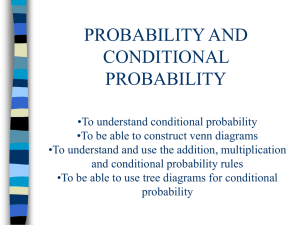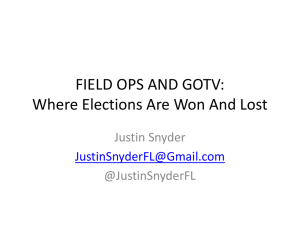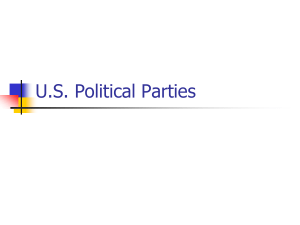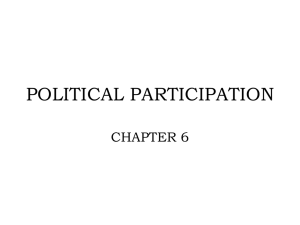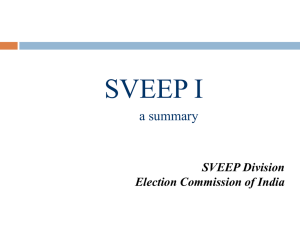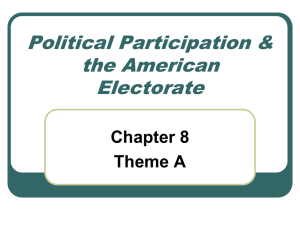the Presentation - New Organizing Institute
advertisement
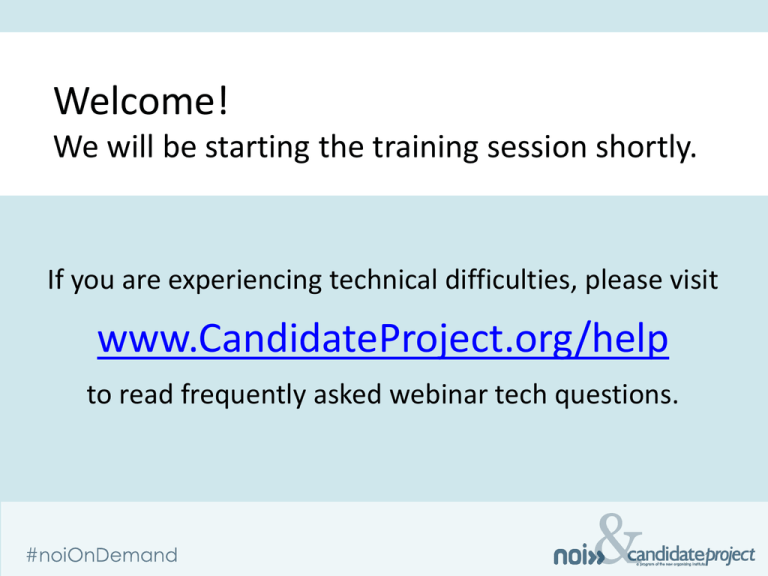
Welcome!
We will be starting the training session shortly.
If you are experiencing technical difficulties, please visit
www.CandidateProject.org/help
to read frequently asked webinar tech questions.
VOTE GOALS
AND TARGETING
Tom Bonier
Clarity Campaign Labs
INTRODUCTIONS
NOI On Demand
You
Norms
FOLLOWING THE LAW
ELECTIONS.NEWORGANIZING.COM
FOLLOWING THE LAW
WWW.AFJ.ORG
Presenter:
Tom Bonier
Partner/Co-founder
Clarity Campaign Labs
OBJECTIVE
To provide an understanding of what
targeting and vote goals are, why they
are helpful, and how they can be
implemented
AGENDA
What is targeting and why is it helpful?
How to calculate a vote goal
How to use targeting to reach your goal
– Persuasion
– GOTV
Using a vote goal to build a program
Case studies
HOW IS TARGETING USEFUL?
• Makes the most of limited resources
• Provides for accountability (Field math!)
• Charts out a clear path to victory
TARGETING – HOW TO BEST USE LIMITED
RESOURCES
UNKNOWN
HIGH
x
HIGH TURNOUT
PERSUASION
HIGH TURNOUT
BASE
SPORADIC
x
SPORADIC
TURNOUT
PERSUASION
SPORADIC
TURNOUT BASE
LOW
x
x
x
x
x
NEW BASE
TURNOUT HISTORY
HIGH
LOW
NEW
PRESUMED SUPPORT
HOW MANY VOTES TO WIN?
{majority of people who vote}
How many people will
vote?
• Historical turnout
• Unique factors to this
year
• Who is in my district?
What % do I need to
win?
• How many candidates
are on the ballot?
• How confident am I in
my turnout #s?
• many votes to win?
VOTE GOAL FORMULA
1. Pick 3 similar elections.
2. Find Turnout Rate
(
Turnout
Registration
+
Turnout
Registration
+
Turnout
Registration
)
= Turnout
/3
Rate
3. Apply turnout to current registration
Turnout Rate x Registered Voters = Expected Vote
4. Find win # (50% + 1, 52% to be safe)
Expected Vote x 50% + 1 = win number.
EXPECTED VOTE: CASE STUDY
Turnout % by Office: Montgomery County, MD
90.0%
80.0%
70.0%
60.0%
50.0%
40.0%
30.0%
20.0%
10.0%
0.0%
1988
1990
1992
1994
AG%
1996
Comp%
1998
2000
Gov%
2002
Pres%
2004
2006
2008
2010
Sen%
1996 and 2008 turnout dips compared to other Presidential years: could this
be explained by the absence of a Senate contest on the ballot?
Credit: Luke Peterson, NCEC
Don’t Let the Perfect
Be the Enemy of the Good
Vote Goal is used for planning…
• Which voters need engagement
• What your voter contact plan should
look like
• How much your plan is likely to cost
• When in doubt, round up!
• Gut check!
TARGETING - SUPPORT
•
•
•
•
Geographic targeting
Supporter IDs
Modeled support
Poll-based demographic targeting
TARGETING - PERSUASION
•
•
•
•
•
Undecided IDs
Soft supporter IDs
Ticket-splitter models
Cross-pressured voters
EIP
TARGETING – HOW TO BEST USE LIMITED
RESOURCES
UNKNOWN
HIGH
x
HIGH TURNOUT
PERSUASION
HIGH TURNOUT
BASE
SPORADIC
x
SPORADIC
TURNOUT
PERSUASION
SPORADIC
TURNOUT BASE
LOW
x
x
x
x
x
NEW BASE
TURNOUT HISTORY
HIGH
LOW
NEW
PRESUMED SUPPORT
VOTE GOALS: PROGRAM DESIGN
Step 1 – Base Vote
How many votes do you already have?
• Likely voting core supporters, no persuasion or
GOTV needed
Step 2 – Vote deficit
How many more votes do you need?
• Vote goal minus Base vote
VOTE GOALS: PROGRAM DESIGN
Step 3 – Base Vote Expansion
How many votes can you gain through
increased base turnout?
• Infrequent voting core supporters
• Voter registration potential
• Gut check – how realistic is this goal in the
context of past precedent?
• How far short does your base vote expansion
goal leave you of erasing your deficit?
VOTE GOALS: PROGRAM DESIGN
Step 4 – Persuasion
What share of the persuadable voters must you
win in order to reach your goal?
• Likely voting persuadable voters
• Set an ID goal; try to convert and ID as many
supporters among your persuasion, at a
minimum, as your vote deficit number
• Gut check – how realistic is this goal in the
context of past precedent, polling, and general
common sense (ie, is your goal to win 90% of
swing voters?)
VOTE GOALS: PROGRAM DESIGN
Step 5 – Budgeting Persuasion vs GOTV
• What does your program look like to reach your
GOTV goal? What will it cost?
• What does your program look like to reach your
persuasion goal? What will it cost?
• Do these allocations make sense? Is one more
efficient than the other?
VOTE GOALS: PROGRAM DESIGN
Step 6 – Implementation
• IDing your win number
• What does your program look like to reach your
persuasion goal? What will it cost?
• Do these allocations make sense? Is one more
efficient than the other?
VOTE GOAL TEMPLATE
Universe
Description Strategy Total Voters Projected Support Projected Turnout Votes
High Turnout Base
0
Sporadic Turnout Base
0
Low Turnout Base
0
High Turnout Persuasion
0
Sporadic Turnout Persuasion
0
Low Turnout Persuasion
0
High Turnout GOP
0
Sporadic Turnout GOP
0
Low Turnout GOP
0
Total
0
Your Vote Goal
Vote Deficit
0
CASE STUDY
Under-represented Mobilization
An anti-immigration politician won an election
by less than 1%.
A group that does issue advocacy/electoral work
notices this result, and discovers that Hispanic
voters comprised only 7% of the district’s
electorate, but a much larger share of the eligible
voters.
CASE STUDY
Under-represented Mobilization
Action plan:
- Take subset of the non-voting Hispanic universe
(easily canvassable doors)
- Knock each door 3 times
- Goal: 50% turnout from target universe
Result: Hispanic voter share increases by 3%,
more than enough to make the difference
QUESTIONS?
WWW.NEWORGANIZING.COM/TOOLB
OX
Interdependent
Leadership
HOW CAN I SUPPORT?
(aka the Snowflake Model)
https://act.neworganizing.com/donate/NOD_Donate_08-2012/


